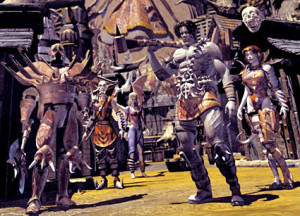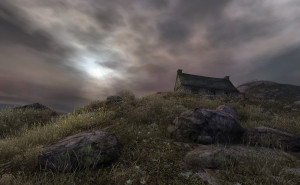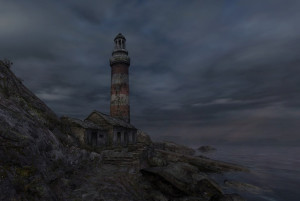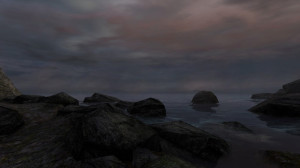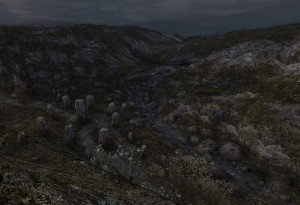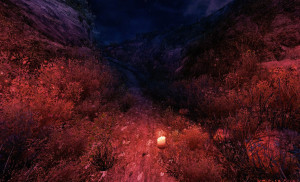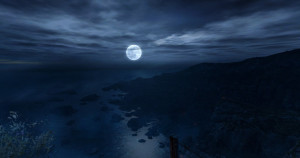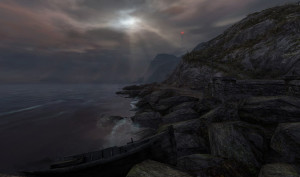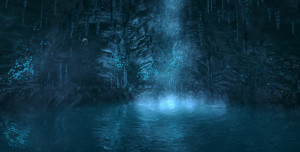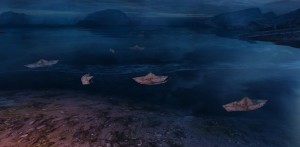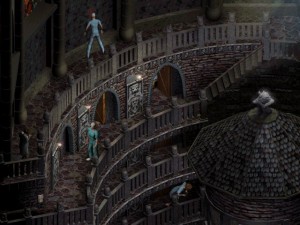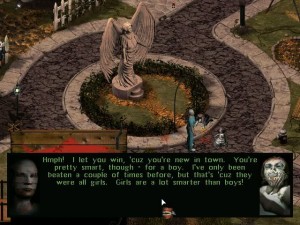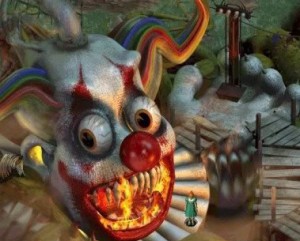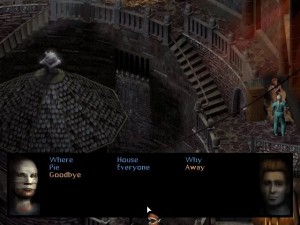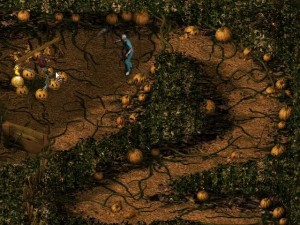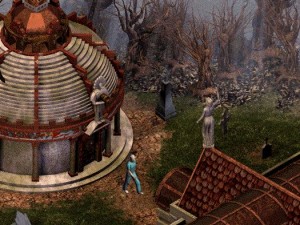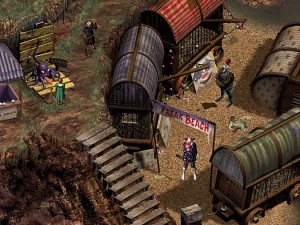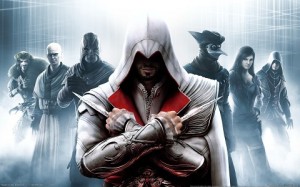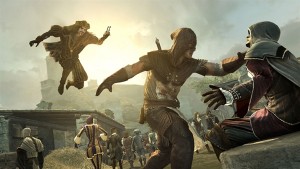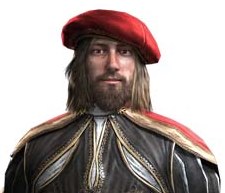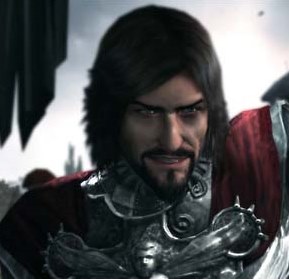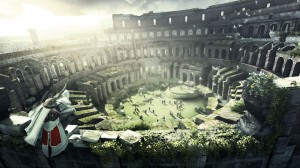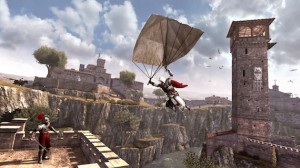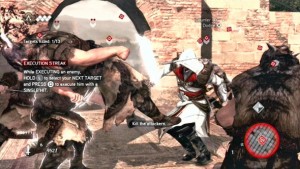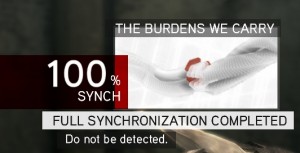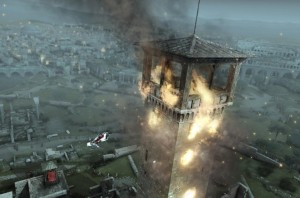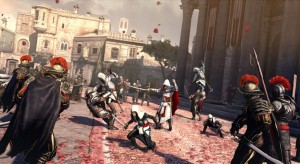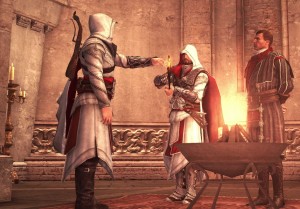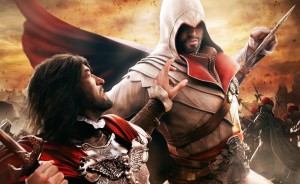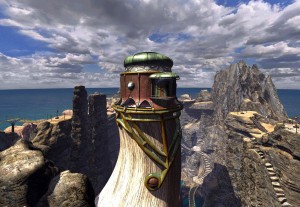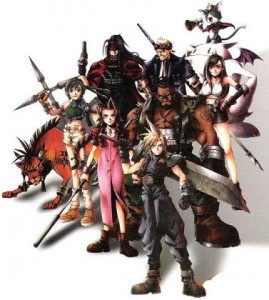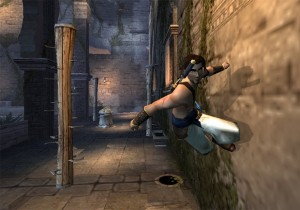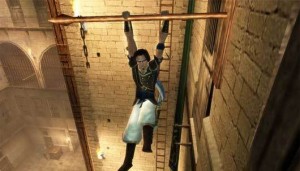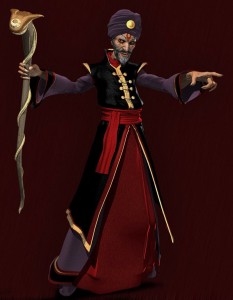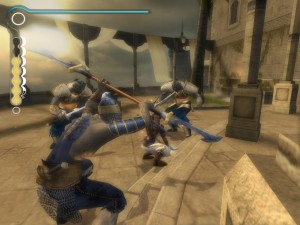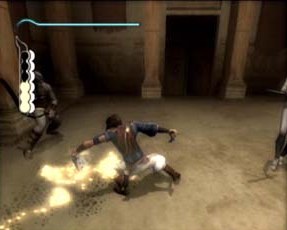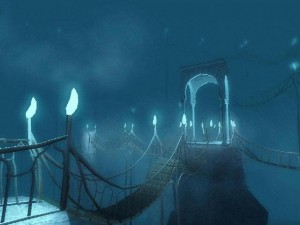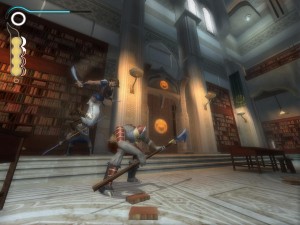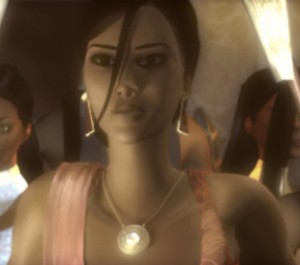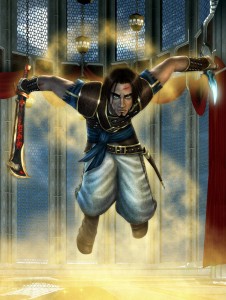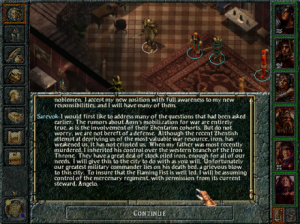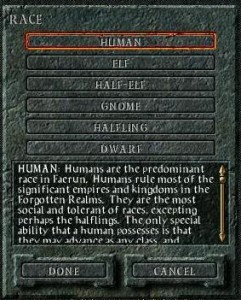 There’s a saying that goes ‘can’t have too much of a good thing’. Well, actually, you can. Take the premise for Bioshock 2, for example. You know that point towards the end of the first game, where Jack had to partially transform himself into a Big Daddy? That was cool, wasn’t it? And unexpected too. So, in the wake of that, putting you into the shoes of a Big Daddy for the entire second game is distinctly less unexpected. And when that’s pretty much the only defining characteristic of the protagonist, killing the surprise really doesn’t play in his favour. Granted, Jack wasn’t the most personable guy around, but at least you heard him speak, and he had a recognisable face. Subject Delta is just a dude in a diving suit. You never even learn his real name.
There’s a saying that goes ‘can’t have too much of a good thing’. Well, actually, you can. Take the premise for Bioshock 2, for example. You know that point towards the end of the first game, where Jack had to partially transform himself into a Big Daddy? That was cool, wasn’t it? And unexpected too. So, in the wake of that, putting you into the shoes of a Big Daddy for the entire second game is distinctly less unexpected. And when that’s pretty much the only defining characteristic of the protagonist, killing the surprise really doesn’t play in his favour. Granted, Jack wasn’t the most personable guy around, but at least you heard him speak, and he had a recognisable face. Subject Delta is just a dude in a diving suit. You never even learn his real name.
 As it turns out, Delta is an Alpha Series Big Daddy. Alpha Series were the first prototype of Big Daddy, not as heavily modified as Rosies or Bouncers and bonded to a single Little Sister, with the disadvantage that, if anything happened to said Little Sister, the Big Daddy would either fall into a coma or become psychotic. Delta was the first of the Alpha Series to be successfully bonded to a Little Sister. Unfortunately, she was Eleanor Lamb, the daughter of Sofia Lamb, a notorious psychiatrist who was invited to Rapture by Andrew Ryan. Lamb’s ideology was diametrically opposed to his–extreme altruism vs extreme individualism–, and she slowly began indoctrinating her patients and founding a cult. Ryan therefore imprisoned her, and Eleanor was turned into a Little Sister. However, Lamb eventually escaped, located Delta, hit him with a Hypnotize Plasmid and forced him to kill himself in front of a horrified Eleanor.
As it turns out, Delta is an Alpha Series Big Daddy. Alpha Series were the first prototype of Big Daddy, not as heavily modified as Rosies or Bouncers and bonded to a single Little Sister, with the disadvantage that, if anything happened to said Little Sister, the Big Daddy would either fall into a coma or become psychotic. Delta was the first of the Alpha Series to be successfully bonded to a Little Sister. Unfortunately, she was Eleanor Lamb, the daughter of Sofia Lamb, a notorious psychiatrist who was invited to Rapture by Andrew Ryan. Lamb’s ideology was diametrically opposed to his–extreme altruism vs extreme individualism–, and she slowly began indoctrinating her patients and founding a cult. Ryan therefore imprisoned her, and Eleanor was turned into a Little Sister. However, Lamb eventually escaped, located Delta, hit him with a Hypnotize Plasmid and forced him to kill himself in front of a horrified Eleanor.
 Cue 10 years later. Eleanor is now grown up and her psychological conditioning has been undone, but she wants no part in her mother’s schemes, which set her up as a messianic figure. Due to receiving massive doses of ADAM, she has developed a psychic connection with all other Little Sisters. Since Delta is the only ‘father’ she’s ever known, she gets the girls to collect samples of his DNA and resurrects him in a Vita Chamber. Due to their bond, Delta has brief telepathic visions of her. However, it’s a guy called Augustus Sinclair, one of Rapture’s top businessmen, who takes it upon himself to guide Delta to her, somewhat like Atlas from the first game. Whether this means that he’s like Atlas in other respects as well…you’ll just have to see for yourself.
Cue 10 years later. Eleanor is now grown up and her psychological conditioning has been undone, but she wants no part in her mother’s schemes, which set her up as a messianic figure. Due to receiving massive doses of ADAM, she has developed a psychic connection with all other Little Sisters. Since Delta is the only ‘father’ she’s ever known, she gets the girls to collect samples of his DNA and resurrects him in a Vita Chamber. Due to their bond, Delta has brief telepathic visions of her. However, it’s a guy called Augustus Sinclair, one of Rapture’s top businessmen, who takes it upon himself to guide Delta to her, somewhat like Atlas from the first game. Whether this means that he’s like Atlas in other respects as well…you’ll just have to see for yourself.
 Chronologically, this takes place eight years after Bioshock. So Ryan is dead, and Rapture is quickly deteriorating even further. This means darker, more dilapidated surroundings, but also more difficult enemies, including two new kinds of Big Daddy (and a third one in the Minerva’s Den DLC), one new kind of Splicer and the Big Sisters: grown-up Little Sisters who have become violent and unstable after years of ADAM consumption and serve as additional protectors for the Little Sisters; they notably have cages on their backs for transporting the little ones, festooned with ribbons, and their oxygen tanks are decorated with childish scribbles. Big Sisters are fast, agile and strong, can throw fireballs, teleport like Houdini Splicers, and drain ADAM from corpses to replenish their health. I like their aesthetic as well: the gangling silhouette and leg braces suggesting a badly-controlled spurt of growth.
Chronologically, this takes place eight years after Bioshock. So Ryan is dead, and Rapture is quickly deteriorating even further. This means darker, more dilapidated surroundings, but also more difficult enemies, including two new kinds of Big Daddy (and a third one in the Minerva’s Den DLC), one new kind of Splicer and the Big Sisters: grown-up Little Sisters who have become violent and unstable after years of ADAM consumption and serve as additional protectors for the Little Sisters; they notably have cages on their backs for transporting the little ones, festooned with ribbons, and their oxygen tanks are decorated with childish scribbles. Big Sisters are fast, agile and strong, can throw fireballs, teleport like Houdini Splicers, and drain ADAM from corpses to replenish their health. I like their aesthetic as well: the gangling silhouette and leg braces suggesting a badly-controlled spurt of growth.
 In general, Bioshock 2 is a lot more female-oriented than its predecessor. Brigid Tenenbaum was the only prominent female character in the first game, but here, besides the Big Sisters, you have Lamb, Grace (one of her aides) and Eleanor. What’s more, Delta works more closely with the Little Sisters, and Lamb’s ideology is like a perversion of the cliché female attribute of selflessness. This is a valid direction for a sequel to take, but Lamb doesn’t have the same aura as Andrew Ryan did and feels a bit tacked on.
In general, Bioshock 2 is a lot more female-oriented than its predecessor. Brigid Tenenbaum was the only prominent female character in the first game, but here, besides the Big Sisters, you have Lamb, Grace (one of her aides) and Eleanor. What’s more, Delta works more closely with the Little Sisters, and Lamb’s ideology is like a perversion of the cliché female attribute of selflessness. This is a valid direction for a sequel to take, but Lamb doesn’t have the same aura as Andrew Ryan did and feels a bit tacked on.
 Gameplay, however, has improved, and combat has been made more strategic. The basic mechanics are the same: Delta needs to fight through hordes of Splicers and tackle Big Daddies (and Big Sisters) using Plasmids and Gene Tonics. However, while Gene Tonic mechanics remain the same, Delta can now use Plasmids and Weapons simultaneously, and both the Plasmid and weapon selections are different. Rather than finding Plasmid upgrades, Delta can now upgrade them himself at Gatherer’s Garden stations, just like weapons. Instead of a wrench, his default melee option is a goddamn drill, like a Bouncer Big Daddy. Instead of a pistol, he has a Rivet Gun, like a Rosie Big Daddy. And instead of a crossbow, he gets a Spear Gun. The Chemical Thrower, however, is gone. What’s more, you must now choose which weapons to upgrade, because there aren’t enough upgrades for all of them. On the plus side, the Research Camera, which grants damage bonuses against enemies, now films instead of taking photos and can be used alongside a weapon during combat, making researching much easier.
Gameplay, however, has improved, and combat has been made more strategic. The basic mechanics are the same: Delta needs to fight through hordes of Splicers and tackle Big Daddies (and Big Sisters) using Plasmids and Gene Tonics. However, while Gene Tonic mechanics remain the same, Delta can now use Plasmids and Weapons simultaneously, and both the Plasmid and weapon selections are different. Rather than finding Plasmid upgrades, Delta can now upgrade them himself at Gatherer’s Garden stations, just like weapons. Instead of a wrench, his default melee option is a goddamn drill, like a Bouncer Big Daddy. Instead of a pistol, he has a Rivet Gun, like a Rosie Big Daddy. And instead of a crossbow, he gets a Spear Gun. The Chemical Thrower, however, is gone. What’s more, you must now choose which weapons to upgrade, because there aren’t enough upgrades for all of them. On the plus side, the Research Camera, which grants damage bonuses against enemies, now films instead of taking photos and can be used alongside a weapon during combat, making researching much easier.
 Delta also gets a Hack Tool, which allows hacking from a distance and can deploy miniature turrets in combat. Hacking has also been made easier. Rather than having to play Pipe Dream like in the first game, now you simply need to stop a moving needle inside a blue or green zone. The latter simply hacks the machine, while the former also grants a bonus (e.g. a discount). Landing in a white zone fails the hack and inflicts damage, while landing in a red zone also triggers an alarm and summons bots.
Delta also gets a Hack Tool, which allows hacking from a distance and can deploy miniature turrets in combat. Hacking has also been made easier. Rather than having to play Pipe Dream like in the first game, now you simply need to stop a moving needle inside a blue or green zone. The latter simply hacks the machine, while the former also grants a bonus (e.g. a discount). Landing in a white zone fails the hack and inflicts damage, while landing in a red zone also triggers an alarm and summons bots.
Everything else stays the same: health and EVE (necessary to use Plasmids) are respectively replenished with First Aid Kits and EVE syringes, as well as food, which can be found or bought at vending machines, as can ammo. Surveillance cameras and bots can be hacked to your advantage, as well as Health Stations, which will poison the Splicers that try to use them. And Vita Chambers are still around to bring Delta back should he suffer an untimely demise.
 The main plot device also remains the same: how to deal with the Little Sisters, who now unfortunately all look identical. Was it so difficult to at least give them different hair colours, like in the first game? Rather than simply choosing whether to rescue or harvest them, Delta can now also have them gather ADAM for him first. Each time he kills a Big Daddy, Eleanor can persuade the latter’s Little Sister that Delta is actually him, so that he can “Adopt” her. The Little Sister will climb onto his shoulders and travel around with him, signalling ADAM-rich corpses that she can harvest. The problem is that this will prompt every Splicer in the vicinity to come after her. They can’t kill her, but they’ll interrupt her, so Delta will have to fight them off. Each Little Sister can gather from two different corpses. Afterwards, Delta needs to take her to a Vent and decide one final time what to do with her. Rescuing the Little Sisters prompts Eleanor to give Delta gifts, but they are less numerous this time around, which is meant to make the ‘harvest or save’ choice more difficult. I still can’t bring myself to harm the poor things, though, so the dilemma is, once again, lost on me. Whatever your decision, once Delta has dealt with four Little Sisters, an ear-splitting shriek will signal a 30s countdown until the arrival of an angry Big Sister, which seems somewhat incongruous if you’re actually trying to save the girls.
The main plot device also remains the same: how to deal with the Little Sisters, who now unfortunately all look identical. Was it so difficult to at least give them different hair colours, like in the first game? Rather than simply choosing whether to rescue or harvest them, Delta can now also have them gather ADAM for him first. Each time he kills a Big Daddy, Eleanor can persuade the latter’s Little Sister that Delta is actually him, so that he can “Adopt” her. The Little Sister will climb onto his shoulders and travel around with him, signalling ADAM-rich corpses that she can harvest. The problem is that this will prompt every Splicer in the vicinity to come after her. They can’t kill her, but they’ll interrupt her, so Delta will have to fight them off. Each Little Sister can gather from two different corpses. Afterwards, Delta needs to take her to a Vent and decide one final time what to do with her. Rescuing the Little Sisters prompts Eleanor to give Delta gifts, but they are less numerous this time around, which is meant to make the ‘harvest or save’ choice more difficult. I still can’t bring myself to harm the poor things, though, so the dilemma is, once again, lost on me. Whatever your decision, once Delta has dealt with four Little Sisters, an ear-splitting shriek will signal a 30s countdown until the arrival of an angry Big Sister, which seems somewhat incongruous if you’re actually trying to save the girls.
 Be that as it may, Delta’s dealings with the Little Sisters affect the ending, just like in the first game. Moreover, they also affect Eleanor’s outlook on life, which is an interesting change and an additional layer of responsibility to his decisions. This also extends to Delta’s dealings with Lamb’s three main allies: sparing or killing them also influences Eleanor.
Be that as it may, Delta’s dealings with the Little Sisters affect the ending, just like in the first game. Moreover, they also affect Eleanor’s outlook on life, which is an interesting change and an additional layer of responsibility to his decisions. This also extends to Delta’s dealings with Lamb’s three main allies: sparing or killing them also influences Eleanor.
A multiplayer mode, entitled Fall of Rapture, has also been added, but since multiplayer’s not my thing, I have no idea what it’s like. On the DLC front, there are two single-player offerings. The first one is called Protector Trials and is reminiscent of the Challenge Rooms from the first game, except that, in keeping with the main game’s mechanic, it involves an unnamed Alpha Series Big Daddy protecting Little Sisters while they gather ADAM. The second DLC, dubbed Minerva’s Den, is more story-based, and follows another prototype Big Daddy called Subject Sigma, as he tries to retake control of Rapture’s supercomputer, The Thinker.
 Overall, I have ambivalent feelings towards Bioshock 2. It’s not a bad game, but something feels lacking. On the one hand, the combat is fun and challenging, and Delta’s Big Daddy-ness does allow for some nifty perks, from being able to wander around underwater to having more interactions with Little Sisters; there’s notably a part of the game where you experience their mental conditioning first-hand. Delta’s influence on Eleanor is also a clever addition. And Rapture is still a compelling, disturbing, nightmarish setting. On the other hand, the storyline isn’t quite up to scratch. Neither Lamb nor Delta is a very interesting character. And the fact that both DLCs also feature Big Daddies as protagonists really doesn’t help. Just how many self-aware Big Daddies are there in Rapture, anyway? Bottom line: if you enjoyed the first Bioshock for its combat, you’ll find plenty to like in this one as well. If you enjoyed it for other reasons, you might feel a tad disappointed.
Overall, I have ambivalent feelings towards Bioshock 2. It’s not a bad game, but something feels lacking. On the one hand, the combat is fun and challenging, and Delta’s Big Daddy-ness does allow for some nifty perks, from being able to wander around underwater to having more interactions with Little Sisters; there’s notably a part of the game where you experience their mental conditioning first-hand. Delta’s influence on Eleanor is also a clever addition. And Rapture is still a compelling, disturbing, nightmarish setting. On the other hand, the storyline isn’t quite up to scratch. Neither Lamb nor Delta is a very interesting character. And the fact that both DLCs also feature Big Daddies as protagonists really doesn’t help. Just how many self-aware Big Daddies are there in Rapture, anyway? Bottom line: if you enjoyed the first Bioshock for its combat, you’ll find plenty to like in this one as well. If you enjoyed it for other reasons, you might feel a tad disappointed.













